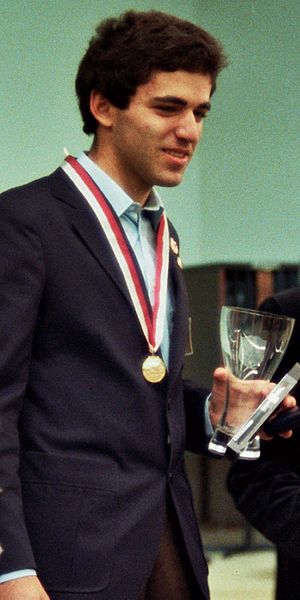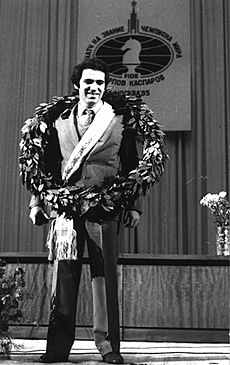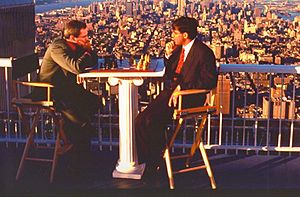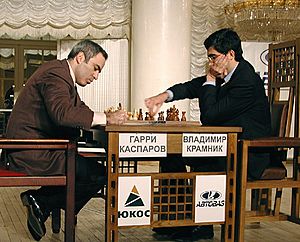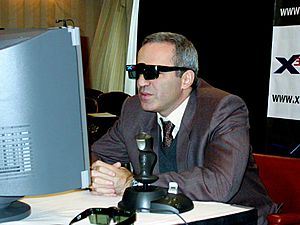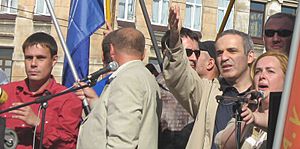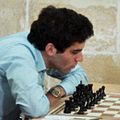Garry Kasparov facts for kids
Quick facts for kids Garry KasparovГарри Каспаров |
|
|---|---|
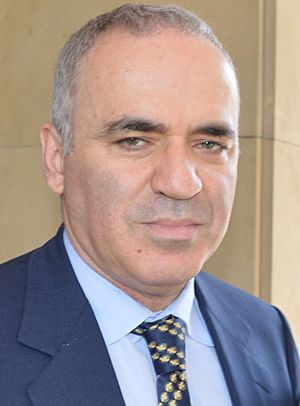
Kasparov in 2015
|
|
| Full name | Garry Kimovich Kasparov |
| Country |
|
| Born | 13 April 1963 Baku, Azerbaijan SSR, Soviet Union |
| Title | Grandmaster (1980) |
| World Champion |
|
| FIDE rating | 2812 (December 2025) |
| Peak rating | 2851 (July 1999) |
| Peak ranking | No. 1 (January 1984) |
Garry Kimovich Kasparov (born on April 13, 1963) is a Russian chess grandmaster who was the World Chess Champion from 1985 to 2000. He is also a writer and political activist. For over 20 years, from 1984 until he retired in 2005, Kasparov was ranked the world's number one chess player.
Kasparov became the youngest-ever undisputed world champion in 1985 at age 22. He defeated the champion at the time, Anatoly Karpov. He held the official FIDE (International Chess Federation) world title until 1993. After a disagreement with FIDE, he started his own chess organization, the Professional Chess Association (PCA).
In 1997, Kasparov played a famous match against Deep Blue, an IBM supercomputer. He became the first world champion to lose a match to a computer in a standard tournament. He held his "Classical" world title until 2000, when he was defeated by Vladimir Kramnik.
After retiring from professional chess, Kasparov became involved in politics. He has been a strong critic of the Russian government and its leader, Vladimir Putin. In 2013, he left Russia because he feared he might be treated unfairly for his political views. He now lives in New York City and has Croatian citizenship.
Contents
Early Life and Introduction to Chess
Garry Kasparov was born in Baku, which was then part of the Soviet Union. His father was Jewish and his mother was Armenian. His father died when Garry was seven years old. When he was twelve, he changed his last name from his father's (Weinstein) to his mother's (Kasparov).
Kasparov started to study chess seriously after solving a chess puzzle his parents had set up. When he was seven, he began attending a youth chess program. At age ten, he started training at a famous chess school run by former world champion Mikhail Botvinnik. His coaches helped him improve his skills and taught him important chess strategies.
In 1978, at age 15, he won a tournament in Minsk. Kasparov said this event was a turning point in his life. It convinced him to make chess his career. He believed he had a real chance to become the world champion.
Chess Career
Rising to the Top
Kasparov quickly became one of the best players in the world. In 1979, he won a major tournament in Banja Luka, Yugoslavia. This victory gave him a high rating and placed him among the world's top players. The next year, he won the World Junior Chess Championship.
By 1983, at age 19, Kasparov was the second-highest-rated player in the world, just behind World Champion Anatoly Karpov. In 1984, he became the youngest-ever world No. 1 player, a record that stood for 12 years. He won the Candidates' Tournament that year, which earned him the right to challenge Karpov for the world championship.
World Championship Matches with Karpov
The first championship match between Kasparov and Karpov in 1984 was very unusual. The winner was supposed to be the first to win six games. Karpov started strong and was leading 4–0. But then, an amazing series of 17 draws followed. Kasparov finally won his first game, but after 48 games, the score was 5–3 for Karpov.
The president of FIDE, the world chess organization, suddenly stopped the match. He said he was concerned about the players' health because the match had gone on for so long. This decision was very controversial. A new match was scheduled for the next year.
Becoming World Champion
The second match in 1985 was a best-of-24-games format. On November 9, 1985, Kasparov won the final game to take the title with a score of 13–11. At 22 years old, he became the youngest undisputed world champion in history.
Kasparov and Karpov played three more championship matches. Kasparov successfully defended his title every time. The matches in 1986, 1987, and 1990 were all very close, but Kasparov always came out on top. In their five championship matches, they played 144 games.
Break with FIDE
Kasparov often disagreed with FIDE's leadership. In 1993, a new challenger, Nigel Short from Great Britain, was set to play Kasparov for the title. Unhappy with FIDE's plans for the match, Kasparov and Short decided to play outside of FIDE's control. They created their own organization, the Professional Chess Association (PCA).
FIDE responded by taking away Kasparov's title and organizing its own championship match. This created a split in the chess world, with two world champions: PCA champion Kasparov and FIDE champion Karpov. The world title remained divided for 13 years. Kasparov later said that breaking away from FIDE was the biggest mistake of his career.
Kasparov defended his PCA title in 1995 against Viswanathan Anand in New York City, winning the match.
Losing the Title
In 2000, Kasparov played a championship match against Vladimir Kramnik in London. Kramnik had once been Kasparov's student. Kramnik was very well-prepared and used a strong defensive strategy that Kasparov couldn't break. Kramnik won the match 8½–6½, and Kasparov lost his title.
Even after losing the championship, Kasparov continued to win major tournaments. He remained the world's highest-rated player. He tried to set up a rematch with Kramnik to reunite the world title, but it never happened.
Retirement from Chess
On March 10, 2005, after winning a major tournament in Linares, Spain, for the ninth time, Kasparov announced his retirement from professional chess. He said he no longer had personal goals in the chess world. He wanted to spend more time writing books and working on his political activities in Russia.
Chess and Computers
Kasparov was one of the first top players to use computers to prepare for games. He used chess database programs to study openings and analyze games.
Matches Against Deep Blue
In 1996, Kasparov played a six-game match against Deep Blue, a supercomputer built by IBM. Kasparov won the match 4–2.
A rematch was held in 1997. This time, Deep Blue had been upgraded and was much stronger. The match was tied after five games. In the final game, Kasparov lost quickly. Deep Blue won the match 3½–2½. It was the first time a reigning world champion had lost a match to a computer under standard time controls.
Kasparov was upset by the loss. He said he saw "deep intelligence and creativity" in some of the computer's moves and suggested that humans might have helped the computer during the games. IBM denied this.
Other Computer Matches
In 1999, Kasparov played a famous game called "Kasparov versus the World." He played as White, and his opponent was the rest of the world, with moves decided by thousands of people voting online. After 62 moves, Kasparov won what he called "the greatest game in the history of chess."
In 2003, he played a match against another computer program, Deep Junior. The match ended in a 3–3 draw. Later that year, he played against the program X3D Fritz using a virtual board and 3D glasses. That match also ended in a draw.
Political Activism
After retiring from chess in 2005, Kasparov became a full-time political activist. He created a social movement called the United Civil Front to promote democracy in Russia. He became a leading figure in The Other Russia, a coalition that opposed the government of Vladimir Putin.
Kasparov organized and participated in many protests. He criticized the Russian government for not being democratic. Because of his activism, he faced challenges from the authorities.
In 2007, he announced he would run for president of Russia. However, he had to withdraw his candidacy. He said his campaign was blocked by the government, which made it impossible for him to rent a hall for his supporters to meet.
In June 2013, Kasparov announced that he would not return to Russia for the time being. He was afraid of being treated unfairly by the government for his political views. He has since lived in New York City and became a Croatian citizen in 2014. From his home in exile, he continues to criticize the Russian government and advocate for democracy.
Legacy and Playing Style
Kasparov is considered by many to be one of the greatest chess players of all time. He was the world's No. 1 ranked player for a record 255 months. His highest rating was 2851, a record that stood for over 13 years until it was broken by Magnus Carlsen.
His playing style was known for being dynamic and aggressive. He was an expert at tactics and was famous for his deep preparation before games, especially in the opening phase. He often compared his style to that of former world champions Alexander Alekhine and Bobby Fischer.
Kasparov has written many books about chess. His most famous work is the five-volume series My Great Predecessors, where he analyzes the games of the world champions who came before him. He also wrote How Life Imitates Chess, which explores the connection between decision-making in chess and in business.
Images for kids
See also
 In Spanish: Garri Kaspárov para niños
In Spanish: Garri Kaspárov para niños
- List of chess games between Kasparov and Kramnik
- Advanced chess



